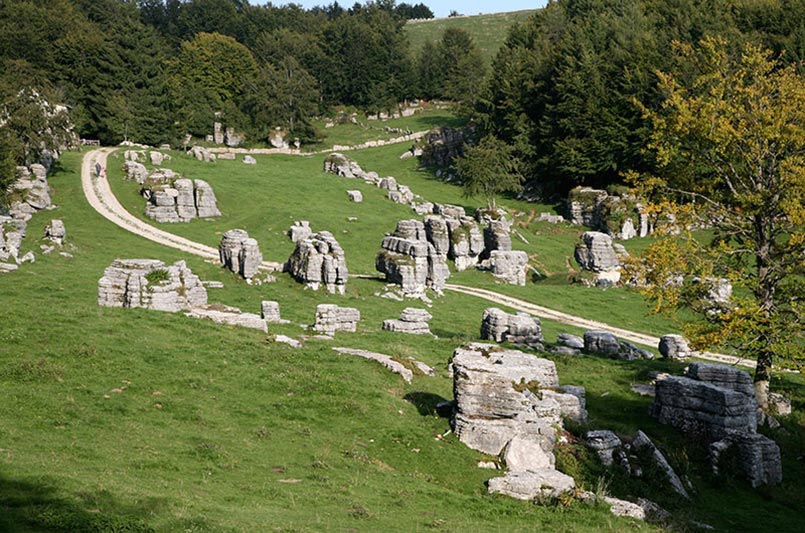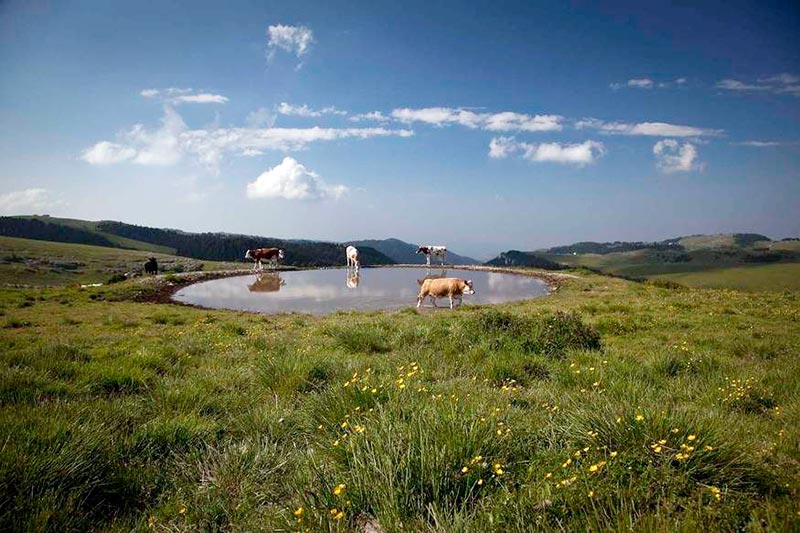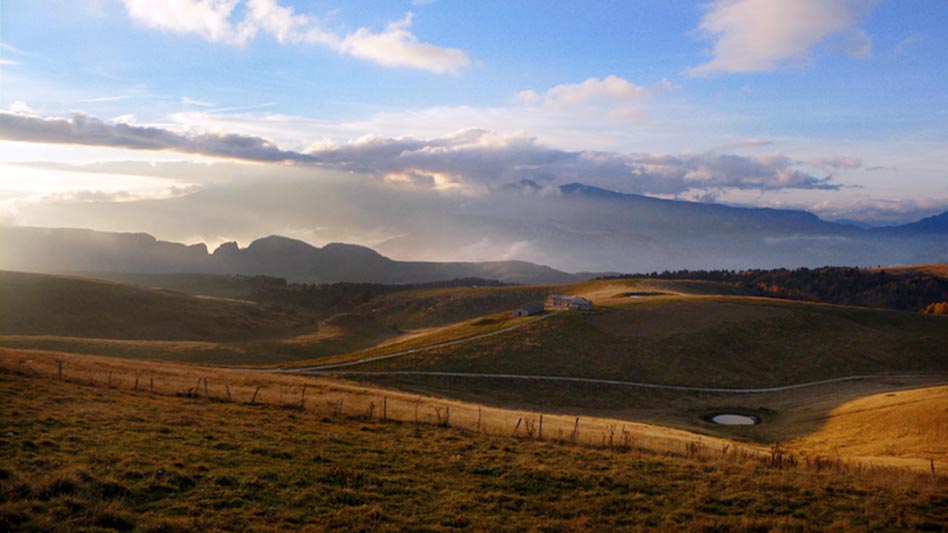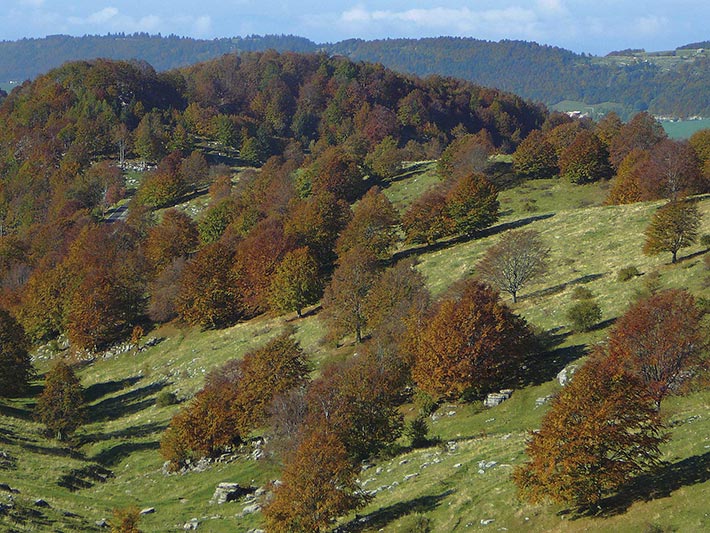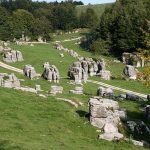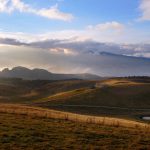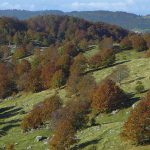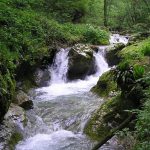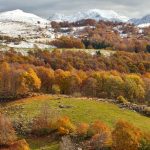Parco Naturale della Lessinia
THE NATURAL PARK OF LESSINIA
The Natural Park of Lessinia, established in 1990, occupies 10,000 hectares of the top part of the Lessini Mountains, between the provinces of Verona and Vicenza.
The municipalities that are part of are:
• Altissimo (VI)
• Badia Calavena (VR)
• Bosco Chiesanuova (VR)
• Cerro Veronese (VR)
• Crespadoro (VI)
• Dolcè (VR)
• Erbezzo (VR)
• Fumane (VR)
• Grezzana (VR)
• Roverè Veronese (VR)
• Roncà (VR)
• San Giovanni Ilarione (VR)
• Sant’Anna d’Alfaedo (VR)
• Selva di Progno (VR)
• Velo Veronese (VR)
• Vestenanova (VR)
The Natural Park of Lessinia is designed to enhance and preserve this land rich in history, archeology, natural features and unique geological, as well as to protect the ethnic heritage, cultural and linguistic populations “Cimbri”.
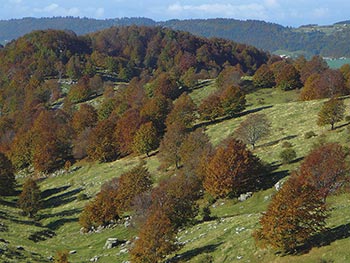 It’s a vast plateau of woods and pastures where nature and traditions of ancient peoples come together: a land of spectacular geological features and districts from the typical stone roofs, as well as fossils are unique in the world, a testament to its origin.
It’s a vast plateau of woods and pastures where nature and traditions of ancient peoples come together: a land of spectacular geological features and districts from the typical stone roofs, as well as fossils are unique in the world, a testament to its origin.
Famous are the fossil deposits of Bolca-Pesciara and Monte Postale, who provided specimens of plant and animal species to the lagoon and the ocean.
Over 50 million years ago in this area, instead of Bolca and all Lessinia, there was a warm sea, rich in tropical flora and fauna. Tens of thousands of fossils, fish and plants of the Tertiary were extracted from Pesciara Bolca and can now be admired in the local Museum of Fossils.
The Cimbri
According to the most reliable historical hypotheses, the Cimbri were settlers from Bavaria or Tyrol who settled in the mountains Lessinian since 1287.
The first urban settlement of this was that the municipality of Roverè Veronese and in about 150 years after they were formed 13 other communities.
In the village of Giazza remains alive even today the linguistic tradition of the Cimbri, a matrix of spoken High German medieval, called “Taucias Gareida”, probably because of the isolated location where this village is located, and consequently the difficulty of trade and communications with the plain.
A Giazza is the “Museum of the Cimbri,” structure that documents the historical, linguistic, cultural of the people of Cimbri.Nel 1974 he also founded the Cultural Association of the Cimbri Lessinia that deals with the preservation of language, culture, of folk traditions and architecture of stone is unique in the world of these people.
The architecture lessinica owes its uniqueness to the type of material used for the construction and form.
The construction uses the slivers of red stone ammonite offered in abundance by the nature of the place in regular plates, which are necessary without cutting. The specificity of this architecture is given in particular the shape of the roof, very old, generically called “gothic” for the pronounced inclination of the slopes that somehow recalls the vertical development of the Nordic architecture.
The “Giassare”
One of the oldest traditions of BLessinia the presence of iceboxes or “Giassare.”
In the past, these spaces were created specifically for the production and sale of ice, mostly those living in the city.
Stone structures were usually circular in shape, with an internal, a puddle oval for the storage of ice.
The Covolo Camposilvano
The special geological features of the territory of Lessinia results in landscapes dominated by sinkholes, caves and natural bridges.
In the town of Velo Veronese are Covolo Camposilvano, the largest karst cave of Veneto’s foothills.
The place is really impressive. It is a chasm about 70m deep, inside you can see a well of a cave collapse and residual; Moreover, in this cavity we have three of the most important rock formations of the Dolomites, the Oolite of San Vigilio, the red stone ammonite and toed.
The place has been inhabited since ancient times by probably well before the last ice age. The attendance was almost uninterrupted even in Roman times and the Middle Ages, and in modern times. This is demonstrated by some artifacts in the Museum of Camposilvano, including animal bones, flint knives and tools, Roman weapons, arrowheads crossbows.
Surely the “Covolo” has always been used as icebox, given the very low temperature that is recorded inside, even in summer.
Valley of the Sphinxes
A Camposilvano you can take a walk in the valley known as the “Valley of the Sphinxes,” where lies a characteristic “rock town”.
It is an erosion of the disintegration of the layers of limestone and Red Ammonite San Vigilio Oolite. The nature of these strange shaped boulders scattered in the meadow of the valley that assume the guise of “mushroom rock” that recall the Egyptian sphinxes.
The Cave of Fumane
The Cave of Fumane is an important prehistoric site. Used as a rock shelter, inside were found many artifacts such as paintings, animal bones, artifacts and decorative objects that have allowed us to reconstruct an environment dating back to 30,000 years ago.
The Ponte di Veja
It’s a extraordinary phenomenon geologico.Il great natural bridge of Veja, located in the Vajo Marchiora, looks like a lintel of entrance to a huge cave is a karst formed by the erosive action of water on limestone rocks that constitute it.
It’s dimensions are impressive: the height varies from 24 to 29 meters, while the thickness of the arch is between 9 and 11 meters.
The immense cavern that originated the bridge, remain a large pit filled with the collapse of boulders and caves at the base under the bridge itself.
Horn of Aquila – Spluga Preta
The Spluga Preta is one of the most famous in the world abyss, a void deep within the Horn of Aquila, in the municipality of Sant’Anna d’Alfaedo. This abyss is the cave that more than any other in Italy is linked to the history of cave exploration: in fact many have been caving expeditions starting in 1925, which have gone up to 800 meters deep, yet without specifying the bottom, and that still continue today to unveil the secrets of this awesome, dark abyss without end.
Also interesting is the biological aspect; in this cavity were found specimens of insects troglobites (ie, living alone in a cave) with somatic adaptations to the darkness of the underworld.
Molina Waterfall Park
Molina is a medieval village with ancient courtyards and stone houses, where the man lived and lives in harmony with his country, in respect of the flora, fauna and traditions of the miller and the hut.
Thanks to the enormous wealth of water in the area, the country has for centuries based its economy on the art milling, with 17 mills active until 1930.
The main activity consisted in grinding grain, but the mills were also used for forging iron, squeezing the nuts to extract the oil and fulling wool.
The Mulino de Lorenzo has recently been restored and opened to the public.
In Molina is the Museum of Botany and the famous Falls Park Molina.
The park is ideal for hiking and nature trails, and thanks to the many well-marked trails, you can immerse yourself in the dense forest, alternating at times by towering cliffs, large caves and, above all, from thundering waterfalls and beautiful spring.
The park covers an area of 80,000 square meters and its special feature is the abundance of water, thanks to the existence of perennial springs placed at the north of the town of Molina.
It’s a beautiful natural oasis at an altitude between 380 and 630 meters. The formation of this area dates back to the Cenozoic (25-30 million years ago) with the outcropping of rocks which were then subjected to the action of atmospheric agents that sculpted.
This area abounds in the presence of water and this has allowed the formation of numerous waterfalls and streams that flow near the rocks. The water moves down the throat sometimes in a quiet manner, forming small pools of green color, and at times, however, in order to give shape to beautiful vibrant and noisy waterfalls.
It’s an idyllic setting, where to get contact with the intact nature of the place and enjoy the coolness of the water bubbling.
